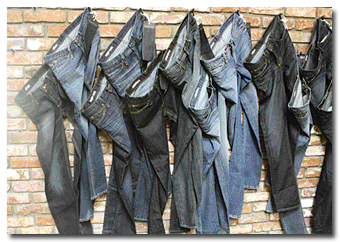Denim North America has been weaving mid- to high-range ring-spun denim fabric at its $87 million state-of-the-art plant in Columbus, Ga., since 2002, when a group of private investors acquired the business, including the plant, from Marubeni Group, Tokyo. As one of only a few denim manufacturers producing fabric in the United States, the company has remained profitable and seen solid growth from the start, and supplies its fabric to many of the leading brands that market and sell jeans and other denim apparel.

Keeping up with trends toward body-hugging yet comfortable fashion apparel, Denim North America weaves stretch denim in addition to conventional denim fabric. Its newest stretch denim
collection, everFLEX, features a cotton warp and an innovative dual core technology in the filling yarn, which comprises spandex and polyester plied together as a core that is wrapped with cotton.
According to Linsey Hinkle, director, merchandising & development, everFLEX offers significantly improved recovery -— greater than 15 percent — and strength — 75-percent better tensile strength and 40-percent better tear strength — over conventional corespun technology; and, in warm weather, a cotton-wrapped corespun yarn is more comfortable than a polyester-wrapped yarn. The technology has relevance not only for tight jeans, but also for the denim leggings that lately have become popular.
“The legging trend really created a need for better recovery and stretch,” Hinkle said, noting that super-stretch fabrics in tight clothing can become baggy after a couple of hours. “A lot of mills, including ours, were combating that by using a poly/spandex yarn in the filling,
which provides excellent recovery and works well for that type of silhouette, but in summer, if you’re wearing polyester next to the skin, it can get a little hot and is just not comfortable. We worked with one of our spinning partners in Mexico and developed technology using polyester and spandex, but corespun inside cotton. So, cotton is next to the skin, but polyester helps with the recovery, and the jeans stay tight and keep their fit.” She added that for the relatively lighter-weight stretch fabrics used in some legging jeans, the added strength provided by polyester helps those fabrics withstand harsh wash treatments often used to give them a worn or distressed look.
The everFLEX collection presently includes four styles, with percentages of cotton/polyester/spandex ranging from 85/14/1 to 80/17/3, and in three shades of blue. The stretchier styles are targeted for leggings, and the less stretchy, for jeans. “Even regular stretch jeans have not been recovering as fully as they could, so even there, everFLEX makes a big difference,” Hinkle said.
Denim North America customers are sampling the fabrics and anticipate a Fall 2012 rollout of new products at retail.
July/August 2011




